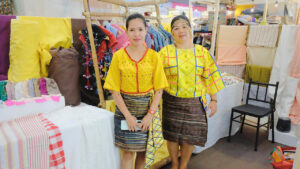Documentary on inabal weaving out

WHEN LoveLove Monon was a young child, she used to sneak into her grandmother’s weaving area to watch her work.
Her grandmother, National Artist Salinta Monon, was a strict woman who was very serious about her craft, and she refused to teach rowdy children. This led LoveLove to start learning the inabal weaving tradition on her own.
The 30-minute documentary Threaded Traditions: The Inabal of the Bagobo-Tagabawa follows LoveLove Monon, now in her late 20s, actively preserving their family’s tradition and honoring the late weaving virtuoso that was her grandmother.
While it took much effort to produce due to necessary exchanges with the datus of the indigenous community in Bansalan, Davao del Sur, the Bagobo-Tagabawas’ willingness to share their culture prevailed.
For director Louise Isabel “Luna” Mendoza, the rarity of having a cultural tradition thrive because of a family’s love for their craft makes it a tale worth sharing with many Filipinos.
“Not all families nowadays continue the traditional crafts in their community. LoveLove is my age and I can relate to that, but the things she does I cannot do,” she said at the documentary’s very first screening on Oct. 12 in Makati.
Having a young woman at the forefront makes this particular story hit close to home for her, she added.
The Threaded Traditions series, referring to the three documentaries produced by HABI: The Philippine Textile Council, first focused on the piña textiles of Panay Island and the ikat of the Cordillera.
The inabal of the Bagobo Tagabawa, while the third and last in the series, is no less as important than the many rich hand-weaving traditions of the Philippines, according to Ms. Mendoza.
“We went to their community without a story, just an inkling of what they do. We got there and were surprised to discover their astounding way of life, how connected they are with nature and with their traditions,” she said.
This involves how the locals must harvest material from specific trees in the area that can provide sturdy weaving fibers and pick the brightly colored flowers that must be used to dye the cloth.
At the screening, many viewers asked Ms. Monon questions about the whole process and listened intently as she explained how proud she was of the tradition handed down by her late grandmother.
Mia Villanueva, HABI’s president, said that the documentary is definitely open to more screenings.
“We will distribute it if we get asked. We’re getting a lot of interest, usually from universities and museums. It exists really for an educational purpose,” she said.For information on film screenings, e-mail likhanghabi@gmail.com. — Brontë H. Lacsamana




